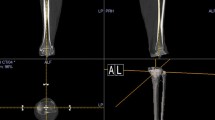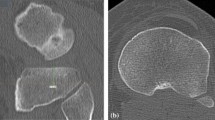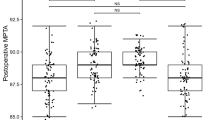Abstract
Background
Although sagittal tibial alignment in total knee arthroplasty (TKA) is important, no landmark exists to achieve reproducible slope. It is theoretically demonstrated that the preoperative planned distance between the skin surface and the rod can be a useful guide for the tibial slope in the previous imaging study. We conducted this retrospective study to confirm whether the results of the study are repeatable in an intra-operative situation.
Methods
Fifty-five consecutive TKAs using the distance from the extramedullary cutting guide rod to the skin surface as a reference guide for the tibial slope were performed and tibial component positioning was compared with 55 knees performed using the accelerometer-based portable navigation. The tibial component alignment was evaluated with a computed tomography (CT)-based three-dimensional (3D) software.
Results
The absolute mean deviation from the targeted slope in the proposed method was significantly smaller than the portable navigation (1.0° and 1.7°, respectively, p = 0.0025). The outlier rate beyond 3° was 0% in the proposed technique (16.4% in the portable navigation, p = 0.0014).
Conclusions
The preoperative planned distance between the skin surface and the guide rod is a useful technique to provide accurate posterior tibial slope in TKA.




Similar content being viewed by others
References
Bargren JH, Blaha JD, Freeman MA (1983) Alignment in total knee arthroplasty. Correlated biomechanical and clinical observations. Clin Orthop 173:178.
Jeffery RS, Morris RW, Denham RA (1991) Coronal alignment after total knee replacement. J Bone Joint Surg Br 73B:709
Lotke PA, Ecker ML (1977) Influence of positioning of prosthesis in total knee replacement. J Bone Joint Surg Am 59A:77
Whiteside LA, Amador DD (1988) The effect of posterior tibial slope on knee stability after Ortholoc total knee arthroplasty. J Arthroplasty 3(Suppl 1):51–57
Bellemans J, Robijns F, Duerinckx J, Banks S, Vandenneucker H (2005) The influence of tibial slope on maximal flexion after total knee arthroplasty. Knee Surg Sports Traumatol Arthrosc 13:193–196
Massin P, Gournay A (2006) Optimization of the posterior condylar offset, tibial slope, and condylar roll-back in total knee arthroplasty. J Arthroplast 21:889–896
Singh G, Tan JH, Sng BY, Awiszus F, Lohmann CH, Nathan SS (2013) Restoring the anatomical tibial slope and limb axis may maximise post-operative flexion in posterior-stabilised total knee replacements. Bone Joint J 95(10):1354–1358
Wasielewski RC, Galante JO, Leighty RM, Natarajan RN, Rosenberg AG (1994) T Wear patterns on retrieved polyethylene tibial inserts and their relationship to technical considerations during total knee arthroplasty. Clin Orthop Relat Res 299:31–43
Jojima H, Whiteside LA, Ogata K (2004) Effect of tibial slope or posterior cruciate ligament release on knee kinematics. Clin Orthop Relat Res 426:194–198
Dennis DA, Channer M, Susman MH, Stringer EA (1993) Intramedullary versus extramedullary tibial alignment systems in total knee arthroplasty. J Arthroplast 8:43–47
Erdem M, Gulabi D, Cecen GS, Avci CC, Asci M, Saglam F (2015) Using fibula as a reference can be beneficial for the tibial component alignment after total knee arthroplasty, a retrospective study. Knee Surg Sports Traumatol Arthrosc 23(7):2068–2073
Rajadhyaksha AD, Mehta H, Zelicof SB (2009) Use of tibialis anterior tendon as distal landmark for extramedllary tibial alignment in total knee arthroplasty: an anatomical study. Am J Orthop 38:E68–70
Schneider M, Heisel C, Aldinger PR (2007) Breusch SJ (2007) Use of palpable tendons for extramedullary tibial alignment in total knee arthroplasty. J Arthroplast 22:219–226
Tsukeoka T, Lee TH, Tsuneizumi Y, Suzuki M (2014) The tibial crest as a practical useful landmark in total knee arthroplasty. Knee 21(1):283–289
Tsukeoka T, Tsuneizumi Y, Lee TH (2014) Accuracy of the second metatarsal as a landmark for the extramedullary tibial cutting guide in total knee arthroplasty. Knee Surg Sports Traumatol Arthrosc 22(12):2969–2974
Confalonieri N, Manzotti A, Pullen C, Ragone V (2005) Computer-assisted technique versus intramedullary and extramedullary alignment systems in total knee replacement: a radiological comparison. Acta Orthop Belg. 71(6):703–709
Manzotti A, Pullen C, Confalonieri N (2008) Computer-assisted alignment system for tibial component placement in total knee replacement: a radiological study. Chir Organi Mov. 91(1):7–11
Pang CH, Chan WL, Yen CH, Cheng SC, Woo SB, Choi ST et al (2009) Comparison of total knee arthroplasty using computer-assisted navigation versus conventional guiding systems: a prospective study. J Orthop Surg (Hong Kong) 17(2):170–173
Cheng T, Zhao S, Peng X, Zhang X (2012) Does computer-assisted surgery improve postoperative leg alignment and implant positioning following total knee arthroplasty? A meta-analysis of randomized controlled trials? Knee Surg Sports Traumatol Arthrosc 20(7):1307–1322
Nam D, Weeks KD, Reinhardt KR, Nawabi DH, Cross MB, Mayman DJ (2013) Accelerometer-based, portable navigation vs imageless, large-console computer-assisted navigation in total knee arthroplasty: a comparison of radiographic results. J Arthroplast 28(2):255–261
Nam D, Cody EA, Nguyen JT, Figgie MP, Mayman DJ (2014) Extramedullary guides versus portable, accelerometer-based navigation for tibial alignment in total knee arthroplasty: a randomized, controlled trial: winner of the 2013 HAP PAUL award. J Arthroplast 29(2):288–294
Tsukeoka T, Tsuneizumi Y (2016) The distance from the extramedullary cutting guide rod to the skin surface as a reference guide for the tibial slope in total knee arthroplasty. Knee 23(2):314–317
Akagi M, Oh M, Nonaka T, Tsujimoto H, Asano T, Hamanishi C (2004) An anteroposterior axis of the tibia for total knee arthroplasty. Clin Orthop Relat Res 420:213–219
Nam D, Cross M, Deshmane P, Jerabek S, Kang M, Mayman DJ (2011) Radiographic results of an accelerometer-based, handheld surgical navigation system for the tibial resection in total knee arthroplasty. Orthopedics 34(10):e615–e621
Bugbee WD, Kermanshahi AY, Munro MM, McCauley JC, Copp SN (2014) Accuracy of a hand-held surgical navigation system for tibial resection in total knee arthroplasty. Knee 21(6):1225–1228
Iorio R, Mazza D, Drogo P, Bolle G, Conteduca F, Redler A, Valeo L, Conteduca J, Ferretti A (2015) Clinical and radiographic outcomes of an accelerometer-based system for the tibial resection in total knee arthroplasty. Int Orthop 39(3):461–466
Huang EH, Copp SN, Bugbee WD (2015) Accuracy of a handheld accelerometer-based navigation system for femoral and tibial resection in total knee arthroplasty. J Arthroplasty 30(11):1906–1910
Steinhaus ME, McLawhorn AS, Richardson SS, Maher P, Mayman DJ (2016) Handheld navigation device and patient-specific cutting guides result in similar coronal alignment for primary total knee arthroplasty: a retrospective matched cohort study. HSS J 12(3):224–234
Fujimoto E, Sasashige Y, Nakata K, Yokota G, Omoto T, Ochi M (2017) Technical considerations and accuracy improvement of accelerometer-based portable computer navigation for performing distal femoral resection in total knee arthroplasty. J Arthroplasty 32(1):53–60
Gharaibeh MA, Solayar GN, Harris IA, Chen DB, MacDessi SJ (2017) Accelerometer-based, portable navigation (KneeAlign) vs conventional instrumentation for total knee arthroplasty: a prospective randomized comparative trial. J Arthroplasty 32(3):777–782
Tsukeoka T, Tsuneizumi Y, Yoshino K (2019) An accelerometer-based navigation did not improve the femoral component positioning compared to a modified conventional technique of pre-operatively planned placement of intramedullary rod in total knee arthroplasty. Arch Orthop Trauma Surg. 139(4):561–567
Author information
Authors and Affiliations
Corresponding author
Ethics declarations
Conflict of interest
The authors declare that they have no competing interests.
Additional information
Publisher's Note
Springer Nature remains neutral with regard to jurisdictional claims in published maps and institutional affiliations.
Rights and permissions
About this article
Cite this article
Tsukeoka, T., Tsuneizumi, Y. & Yoshino, K. Preoperative planned distance between the skin surface and the guide rod provides accurate posterior tibial slope in total knee arthroplasty. Arch Orthop Trauma Surg 139, 1133–1139 (2019). https://doi.org/10.1007/s00402-019-03212-9
Received:
Published:
Issue Date:
DOI: https://doi.org/10.1007/s00402-019-03212-9




